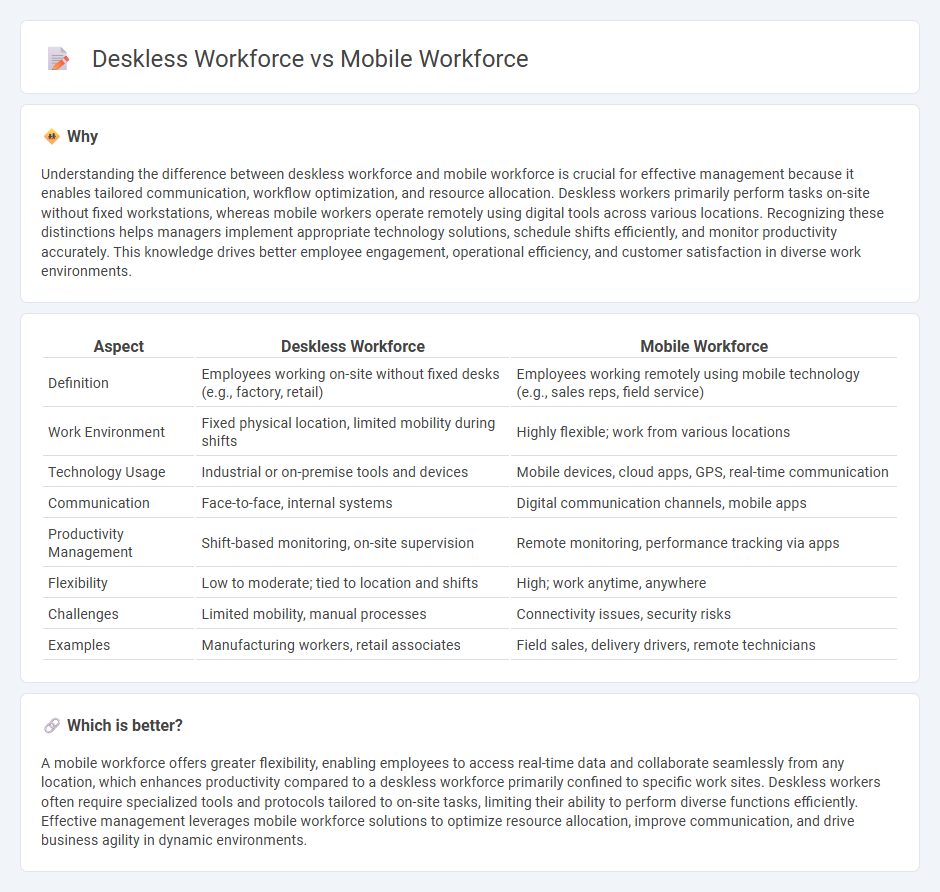
The deskless workforce primarily operates in fixed locations such as retail stores or manufacturing plants, relying on onsite resources and face-to-face collaboration. In contrast, the mobile workforce leverages mobile technology to perform tasks remotely, enabling flexibility and real-time communication across diverse environments. Explore key strategies to effectively manage both deskless and mobile teams for enhanced productivity and engagement.
Why it is important
Understanding the difference between deskless workforce and mobile workforce is crucial for effective management because it enables tailored communication, workflow optimization, and resource allocation. Deskless workers primarily perform tasks on-site without fixed workstations, whereas mobile workers operate remotely using digital tools across various locations. Recognizing these distinctions helps managers implement appropriate technology solutions, schedule shifts efficiently, and monitor productivity accurately. This knowledge drives better employee engagement, operational efficiency, and customer satisfaction in diverse work environments.
Comparison Table
| Aspect | Deskless Workforce | Mobile Workforce |
|---|---|---|
| Definition | Employees working on-site without fixed desks (e.g., factory, retail) | Employees working remotely using mobile technology (e.g., sales reps, field service) |
| Work Environment | Fixed physical location, limited mobility during shifts | Highly flexible; work from various locations |
| Technology Usage | Industrial or on-premise tools and devices | Mobile devices, cloud apps, GPS, real-time communication |
| Communication | Face-to-face, internal systems | Digital communication channels, mobile apps |
| Productivity Management | Shift-based monitoring, on-site supervision | Remote monitoring, performance tracking via apps |
| Flexibility | Low to moderate; tied to location and shifts | High; work anytime, anywhere |
| Challenges | Limited mobility, manual processes | Connectivity issues, security risks |
| Examples | Manufacturing workers, retail associates | Field sales, delivery drivers, remote technicians |
Which is better?
A mobile workforce offers greater flexibility, enabling employees to access real-time data and collaborate seamlessly from any location, which enhances productivity compared to a deskless workforce primarily confined to specific work sites. Deskless workers often require specialized tools and protocols tailored to on-site tasks, limiting their ability to perform diverse functions efficiently. Effective management leverages mobile workforce solutions to optimize resource allocation, improve communication, and drive business agility in dynamic environments.
Connection
The deskless workforce relies heavily on mobile technology to perform tasks efficiently outside traditional office settings, making mobile workforce solutions essential for real-time communication and workflow management. Mobile devices enable deskless workers to access critical information, update job statuses, and collaborate with teams seamlessly across various locations. Integration of mobile workforce management tools enhances productivity and operational agility by streamlining scheduling, task allocation, and performance tracking for deskless employees.
Key Terms
Remote Access
The mobile workforce relies heavily on remote access technologies to perform tasks from various locations, ensuring flexibility and continuous productivity beyond traditional office settings. Deskless workers, often in industries like healthcare, retail, and construction, require seamless remote access to real-time data and communication tools directly from their mobile devices to complete job-specific tasks efficiently. Explore in-depth insights on how remote access solutions empower both mobile and deskless workforces to optimize operations and enhance workforce mobility.
Flexibility
The mobile workforce thrives on flexibility by enabling employees to work from various locations using mobile devices and cloud technologies, maximizing productivity beyond traditional office settings. Deskless workforce members, often in industries like retail, healthcare, and field services, rely on specialized tools and real-time communication to adapt quickly to dynamic environments without fixed workstations. Explore how enhancing flexibility in both mobile and deskless workforces drives operational efficiency and employee satisfaction.
Connectivity
The mobile workforce relies heavily on seamless connectivity through smartphones, tablets, and laptops to access cloud-based applications and real-time data from any location, enabling efficient task management and communication. Deskless workers, often operating in industries like retail, healthcare, and logistics, require robust, reliable wireless networks and rugged mobile devices optimized for on-the-go connectivity to maintain productivity and safety. Explore the latest solutions and strategies to enhance connectivity for both mobile and deskless workforces.
Source and External Links
What is a Mobile Workforce? - IBM - A mobile workforce consists of employees who are not tied to a single physical location and are connected through mobile technology such as smartphones and laptops, enabling them to work from various places including hybrid and deskless roles across multiple industries.
What is a Mobile Workforce in Field Service? - Salesforce - This describes a mobile workforce as teams working outside of traditional offices, who can expand geographic reach, improve response times, optimize resources, and adapt easily to changing demands with the support of specialized mobile workforce management software.
All about Mobile Workforce - Definition, Challenges, Benefits and more - A mobile workforce works via mobile devices allowing flexible hours and locations, improving creativity and productivity for employees while enabling companies to collect data faster and support customers better across dispersed teams.
 dowidth.com
dowidth.com